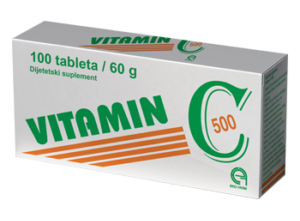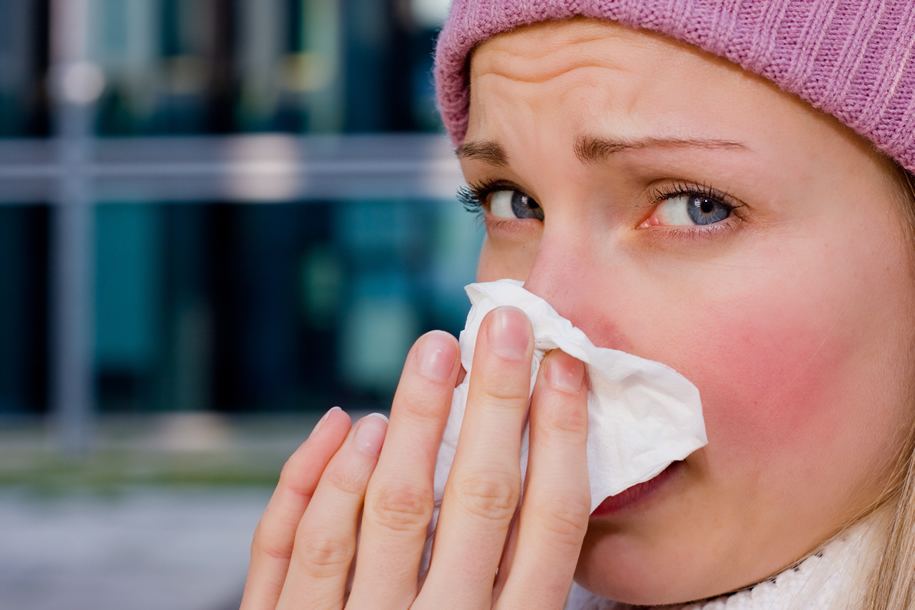The common cold is an acute viral infectious disease, which primarily affects the major structures of the upper respiratory tract, which leads to the inflammation of throat (pharyngitis), voice box (laryngitis), nose (rhinitis) and sinus cavities (sinusitis). It is the most common infection in otherwise healthy population and the main reason why we visit our doctor. Infection occurs rapidly, with the incubation period of just 2-3 days. It is typically repeated up to 4 times a year in adults and up to 12 times a year in school children and the elderly. Colds may occur during the whole year, however, there is an increased incidence during autumn and winter months. Seasonality depends on both environmental factors (causative agents occur more often during winter, low temperature induces changes in the respiratory system, low humidity increases viral transmission rates) and social factors (people spending more time indoors, beginning of the school year, insufficient room ventilation).
What are the symptoms of a common cold?
Symptoms of a common cold are usually mild and non-specific and they include nasal congestion, runny nose, sneezing, sore throat and cough, often accompanied by a slight muscle ache and a mild headache. Fever is generally not present, although a low-grade one may occur in some cases, typically in infants and young children. Most of the symptoms usually last from 7 to 10 days in adults, except cough, that can last up to 3 weeks. Young children, the elderly and people with chronic diseases, on the other hand, experience prolonged symptoms, due to the weaker immune functions.
What causes the common cold and how is it transmitted?
As previously mentioned, common cold is a viral disease, which typically affects the organs of the upper respiratory tract. Although it can be caused by more than 200 different types of viruses, it is most frequently caused by rhinoviruses (up to 80% of all colds). Other viruses include human coronavirus, adenoviruses, human parainfluenza viruses and human respiratory syncytial virus. All of these viruses have low pathogenicity and tend to cause milder symptoms than the human influenza viruses, the main causative agents of flu.
Common cold can be transmitted via aerosols of respiratory droplets that contain the virus, contaminated surfaces (hand-to-surface) contact and direct person (hand-to-hand) contact. Transmission is very often in nurseries, schools, public transportation, as well as all places that include people sitting in close proximity to one another. It is virtually impossible to avoid the common cold after being exposed to an infected person. That is due to the widespreadness, high contagiousness and resilience of the rhinovirus (some serotypes may survive for over 18 hours in the environment, outside the host).
How is the common cold treated?
Treatment of the common cold is symptomatic, since there are still no effective antiviral drugs available. Vaccine development also proved to be difficult, due to the large number of rapidly mutating viruses involved as causative agents. The disease itself is frequently both self-diagnosed and self-treated, although it is one of the main reasons why we visit our doctor too. It is efficiently treated with over-the-counter (OTC) drugs and various dietary supplements, that help improve symptoms, such as nasal congestion, sore throat, hoarseness and cough. Most commonly used OTC drugs are analgesics (relieve pain caused by muscle ache or a headache), antipyretics (lower the body temperature in febrile patients), nasal decongestants (relieve nasal congestion) and cough medicines (suppress a dry cough, improve chesty cough). Dietary supplements in the form of oriblettes, pastilles or lozenges, which contain antiseptic and anti-inflammatory substances, are often used for treating sore throat and hoarseness. Vitamin C dietary supplements may shorten the duration of illness, when taken on a regular basis. Antibiotics, on the other hand, have no effect against viral infections and should not be used in the common cold treatment, except for treating possible bacterial complications (sinusitis, otitis media, bacterial pneumonia). Unfortunately, they are still frequently prescribed, which further leads to the creation of antibiotic-resistant strains of bacteria.
Methods of prevention
Common cold is a highly contagious and widespread disease, but it can be prevented on a certain level by following several important guidelines:
- avoid direct contact with another infected person for the first 3 days of their illness
- wash hands thoroughly on a regular basis (especially important for children)
- avoid touching the mouth or nose (common portals of entry for the virus)
- wear a face mask when being near to the infected person
- wear a face mask if you are infected, to avoid passing the cold to other people
- avoid crowded areas during the common cold season
- do not share drinks or food with other people
by: mr ph Iva Majstorović, posted on December 11, 2014
References
1. Eccles R (November 2005). “Understanding the symptoms of the common cold and influenza”.
Lancet Infect Dis 5 (11): 718–25.
http://www.thelancet.com/journals/laninf/article/PIIS1473-3099%2805%2970270-X/fulltext
2. Heikkinen T, Järvinen A (January 2003). “The common cold”. Lancet 361 (9351): 51–9.
http://www.thelancet.com/journals/lancet/article/PIIS0140-6736%2803%2912162-9/fulltext
3. Michael Rajnik; Robert W Tolan (13 Sep 2013). “Rhinovirus Infection” Medscape Reference.
http://emedicine.medscape.com/article/227820-overview#a0101
4. Diseases and Conditions/ Common cold.
http://www.mayoclinic.org/diseases-conditions/common-cold/basics/definition/con-20019062
5. Understanding the Common cold – the Basics.
http://www.webmd.com/cold-and-flu/cold-guide/understanding-common-cold-basics
 Vitamin C-500 is a dietary supplement based on vitamin C, which is essential for improving vitality of our body and it’s natural defense mechanisms. Without sufficient amount of this vitamin many physiological functions, such as growth and development, or antioxidant defense, would simply not be possible. It is an essential nutrient, which means that it cannot be synthesized by the body, therefore, it must be provided continuously through a healthy diet and dietary supplements, when necessary.
Vitamin C-500 is a dietary supplement based on vitamin C, which is essential for improving vitality of our body and it’s natural defense mechanisms. Without sufficient amount of this vitamin many physiological functions, such as growth and development, or antioxidant defense, would simply not be possible. It is an essential nutrient, which means that it cannot be synthesized by the body, therefore, it must be provided continuously through a healthy diet and dietary supplements, when necessary.
